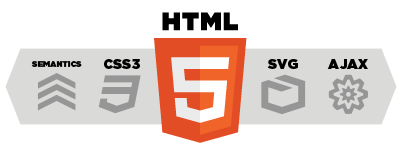HTML 5 does not have the same syntax rules as XHTML where we needed lower case tag names, quoting our attributes,an attribute had to have a value and to close all empty elements.
But HTML5 is coming with lots of flexibility and would support the followings:
Uppercase tag names.
Quotes are optional for attributes.
Attribute values are optional.
Closing empty elements are optional.
The DOCTYPE
DOCTYPEs in older versions of HTML were longer because the HTML language was SGML based and therefore required a reference to a DTD.
HTML 5 authors would use simple syntax to specify DOCTYPE as follows:
DOCTYPE html>
All the above syntax is case-insensitive.
Character Encoding
HTML 5 authors can use simple syntax to specify Character Encoding as follows:
<meta charset="UTF-8">
All the above syntax is case-insensitive.
The
It's common practice to add a type attribute with a value of "text/javascript" to script elements as follows:
<script type="text/javascript" src="scriptfile.js">script>
HTML 5 removes extra information required and you can use simply following syntax:
<script src="scriptfile.js">script>
The
tag:So far you were writing as follows:
<link rel="stylesheet" type="text/css" href="stylefile.css">
HTML 5 removes extra information required and you can use simply following syntax:
HTML5 Elements:
HTML5 elements are marked up using start tags and end tags. Tags are delimited using angle brackets with the tag name in between.
The difference between start tags and end tags is that the latter includes a slash before the tag name.
Following is the example of an HTML5 element:
<p>...p>
HTML5 tag names are case insensitive and may be written in all uppercase or mixed case, although the most common convention is to stick with lowercase.
Most of the elements contain some content like
...
contains a paragrap. Some elements, however, are forbidden from containing any content at all and these are known as void elements. For example, br, hr, link and meta etc.Here is a complete list of HTML5 Elements.
HTML5 Attributes:
Elements may contain attributes that are used to set various properties of an element.
Some attributes are defined globally and can be used on any element, while others are defined for specific elements only. All attributes have a name and a value and look like as shown below in the example.
Following is the example of an HTML5 attributes which illustrates how to mark up a div element with an attribute named class using a value of "example":
...
Attributes may only be specified within start tags and must never be used in end tags.
HTML5 attributes are case insensitive and may be written in all uppercase or mixed case, although the most common convention is to stick with lowercase.
Here is a complete list of HTML5 Attributes.
HTML5 Document:
The following tags have been introduced for better structure:
- section: This tag represents a generic document or application section. It can be used together with h1-h6 to indicate the document structure.
- article: This tag represents an independent piece of content of a document, such as a blog entry or newspaper article.
- aside: This tag represents a piece of content that is only slightly related to the rest of the page.
- header: This tag represents the header of a section.
- footer: This tag represents a footer for a section and can contain information about the author, copyright information, et cetera.
- nav: This tag represents a section of the document intended for navigation.
- dialog: This tag can be used to mark up a conversation.
- figure: This tag can be used to associate a caption together with some embedded content, such as a graphic or video.
The markup for an HTM 5 document would look like the following:
DOCTYPE html>
<html>
<head>
<meta charset="utf-8">
<title>...title>
head>
<body>
<header>...header>
<nav>...nav>
<article>
<section>
...
section>
article>
<aside>...aside>
<footer>...footer>
body>
-
Average:
-
Reads(824)
-
Trackback(0)
-
Permalink





















Comments (0)